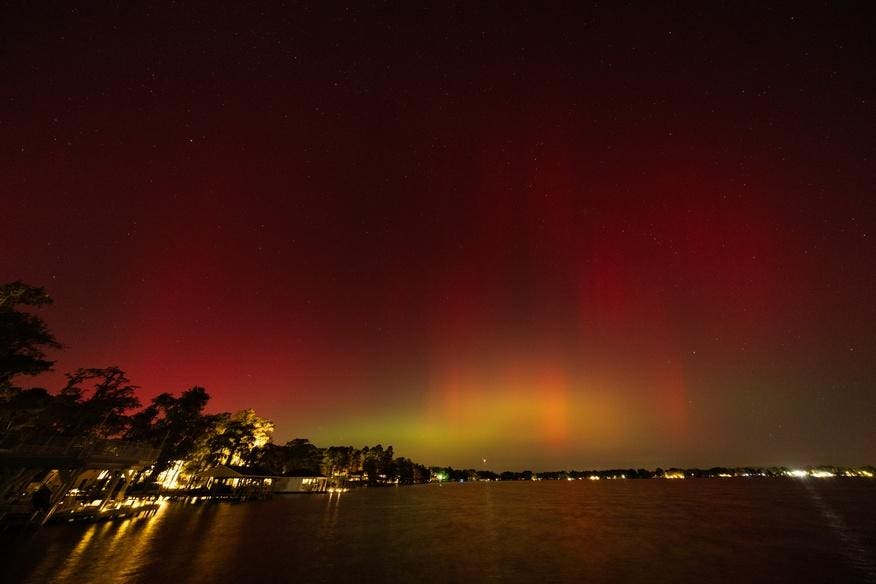The Northern Lights appear in the sky during a geomagnetic storm on October 10, 2024 in White Lake, … More North Carolina. (Photo by Lance King/Getty Images)
Getty Images
The Northern Lights may be visible in the U.S. this week, according to the National Oceanic and Atmospheric Administration’s Space Weather Prediction Center, which is predicting geomagnetic activity that could result in aurora being glimpsed in as many as 11 U.S. states on Sunday, May 4, 2025.
NOAA’s aurora viewlines have potential aurora displays that are possible in northern U.S. states and Canada. A total of 11 U.S. states have a chance of seeing the aurora on the northern horizon on Sunday night, with Alaska and those on the U.S.-Canada border having the highest chance.
The aurora viewline for Sunday, May 4, 2025.
NOAA
Where The Northern Lights May Be Visible
Parts of U.S. states that could potentially see aurora, according to NOAA, include Alaska, Washington, northern Idaho, Montana, northern Wyoming, North Dakota, South Dakota, Minnesota, Wisconsin, Michigan and Maine. Areas far from light pollution are likely to get the best views.
When To See The Northern Lights
Exactly when and where aurora becomes visible this week will be down not to predictions but data coming in from NASA’s DSCOVR and ACE satellites. Orbiting the sun from around a million miles from Earth, they give a roughly 30-minute warning of aurora displays after measuring the solar wind’s speed and magnetic intensity. Check NOAA’s 30-minute forecast or use the Glendale App for up-to-the-minute forecasts.
The Best Way To Photograph The Northern Lights
If your smartphone has a “Night Mode” feature, that should be good enough to get a more than impressive souvenir shot of the aurora. It likely means a long exposure of between five and 10 seconds, which will look much better if you do three things:
- Use your primary lens, NOT the super-wide lens (which is inferior).
- Use a basic smartphone holder and a small tripod to prevent any camera shake, keeping your images sharp. Failing that, support your phone on something solid, such as a gatepost or vehicle.
- Shoot in raw if you have the option, making improving your photos easier using simple edits.
Key Background
The Northern Lights are caused by the solar wind, a stream of charged particles from the sun interacting with Earth’s magnetic field. Although the magnetic field deflects much of it, some charged particles accelerate along the magnetic field lines toward the polar regions, where they collide with oxygen and nitrogen atoms, exciting them and causing them to release energy as light.
The possibility of displays of the aurora borealis at more southerly latitudes comes from a spike in solar activity, which is currently at a 23-year high due to the current solar maximum period. Geomagnetic storms and aurora are expected to continue through 2025 and 2026.
Wishing you clear skies and wide eyes.
